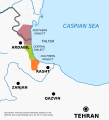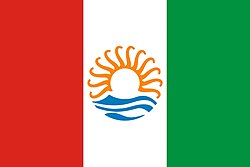Talyšové
| Talyšové | |
|---|---|
 Talyšský folklorní soubor | |
| Populace | |
| půl milionu až milion | |
| 112 000 | |
| 430 000[1] | |
| Jazyk(y) | |
| Talyština | |
| Náboženství | |
| Islám (převážně ší'itský) | |
| Příbuzné národy | |
| Íránské národy, Kavkazané | |
Talyšové jsou íránská[2][3][4][5][6][7] etnická skupina žijící v jižním Ázerbájdžánu a severním Íránu od Kaspického moře po Talyšské hory. Hovoří talyštinou, která patří mezi íránské jazyky.
Počet Talyšů v Íránu se odhaduje na 430 000, žijí převážně v Talešském kraji provincie Gílán. Ázerbájdžánští Talyšové obývají okolí města Lenkoran. Podle oficiálního sčítání lidu je jich 112 000, organizace talyšských nacionalistů však odhadují počet na více než osm set tisíc. Vyznávají převážně ší'itský islám, v němž však přetrvává množství původních pohanských představ, živí se zemědělstvím, pastevectvím a řemesly.
Talyšové se prohlašují za potomky starověkých Kadusiů. Byli poddanými safíovské říše, v letech 1747 až 1819 existoval nezávislý Talyšský chanát, který se pak stal součástí carského Ruska. 15. května 1919 vyhlásili místní bolševici Mughanskou sovětskou republiku, která zanikla v červenci téhož roku. Po rozpadu Sovětského svazu byla v létě 1993 nakrátko založena Talyš-Mughanská autonomní republika. Po potlačení vzpoury ázerbájdžánskými vojsky byl prezident tohoto státu Alikram Hummatov odsouzen k smrti, trest mu byl později zmírněn na doživotní vězení. Po protestech zahraničních lidskoprávních organizací byl roku 2004 propuštěn a vypovězen do Nizozemska, kde roku 2007 založil Talyšské národní hnutí, které bylo v roce 2014 přijato do Organizace nezastoupených států a národů.
Mapa talyšských dialektů
Vlajka Talyšů
Reference
- ↑ Tore Kjeilen. Talysh - LookLex Encyclopaedia [online]. [cit. 2015-10-17]. Dostupné v archivu pořízeném dne 2016-05-29. (anglicky)
- ↑ "Jamie Stokes,"Encyclopedia of the Peoples of Africa and the Middle East, Volume 1",Infobase Publishing, 2009. pp 682: "The Talysh are an Iranian people, most of whom now live in the Republic of Azerbaijan, on the southwestern shore of the Caspian Sea, "
- ↑ M. Wesley Shoemaker, "Russia and the Commonwealth of Independent States 2008", Stryker-Post Publications, 2008. pp 141: "Here the Talysh, an Iranian people, live in their mountainous villages and support themselves by weaving rugs and carpets by hand in the traditional way." [1]
- ↑ James Stothert Gregory, "Russian land, Soviet people: a geographical approach to the U.S.S.R.", Pegasus, 1968. pp 161: "Smaller Iranian groups are the Talysh and Kurds of Transcaucasia" [2]
- ↑ Michael P. Croissant, "The Armenia-Azerbaijan conflict: causes and implications", Greenwood Publishing Group, 1998. pp 67: "Talysh, an Iranian people whose language belongs to the northwest Iranian language group" [3]
- ↑ Charles Dowsett, "Sayatʻ-Nova: an 18th-century troubadour : a biographical and literary study", Peeters Publishers, 1997. pp 174: "Talish is the name of an Iranian people in Gilan" [4]
- ↑ Garnik Asatrian & Habib Borjian (2005.). Talish and the Talashis (State of Research). Iran & the Caucasus, 9 (1), pp. 43–72 pp 46: "Despite the fact that the Talishis, both in Iran and in the north, have explicit Iranian identity, the situation with the Talishis in Azerbaijan Republic, living as an enclave within the predominantly Turkic environment, has inspired the southern intellectual milieu as well." pp 47: "The structures of both ethnonyms, Καδούσ- (Cadus-) and Tāliš, are similar: ... Despite the obvious speculative character of the above etymology, still the Καδούσ-/Tāliš identification must not be discarded from the agenda of the ethnic history of the region, at least as a working hypothesis."
Externí odkazy
 Obrázky, zvuky či videa k tématu Talyšové na Wikimedia Commons
Obrázky, zvuky či videa k tématu Talyšové na Wikimedia Commons - https://archive.today/20160529202325/http://i-cias.com/e.o/talysh_l.htm
- https://web.archive.org/web/20150923211119/http://www.cria-online.org/5_4.html
- http://www.czech-press.cz/index.php?option=com_content&view=article&id=7034:ivot-v-objeti Archivováno 25. 7. 2020 na Wayback Machine.
Média použitá na této stránce
Flag of Iran. The tricolor flag was introduced in 1906, but after the Islamic Revolution of 1979 the Arabic words 'Allahu akbar' ('God is great'), written in the Kufic script of the Qur'an and repeated 22 times, were added to the red and green strips where they border the white central strip and in the middle is the emblem of Iran (which is a stylized Persian alphabet of the Arabic word Allah ("God")).
The official ISIRI standard (translation at FotW) gives two slightly different methods of construction for the flag: a compass-and-straightedge construction used for File:Flag of Iran (official).svg, and a "simplified" construction sheet with rational numbers used for this file.
Autor: Gulustan, Licence: CC BY-SA 3.0
Фольклорный ансамбль на празднике Новруз
Autor: Franko1Tbilisi, Licence: CC BY-SA 3.0
Флаг Талыш-Муганской Автономной Республики (Flag of Talysh-Mugan Autonomous Republic) избранный Милли Меджлисов (Национальным Советом) в 1993 году.






